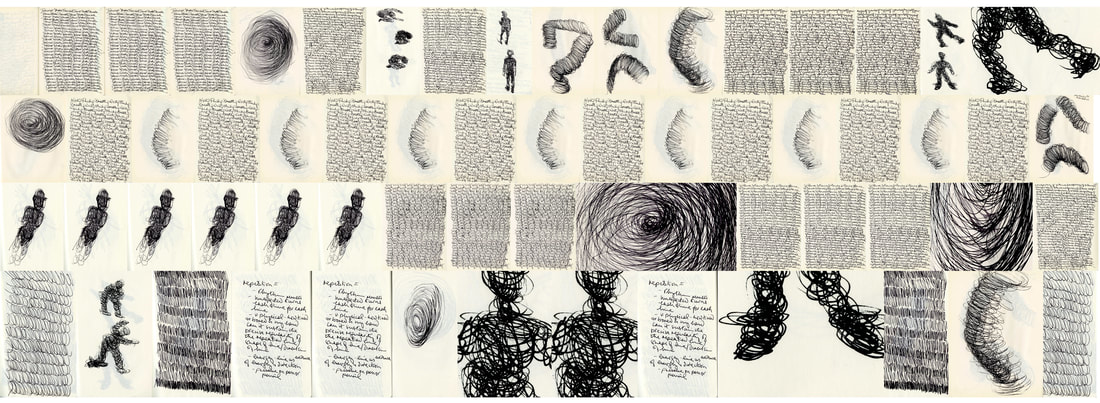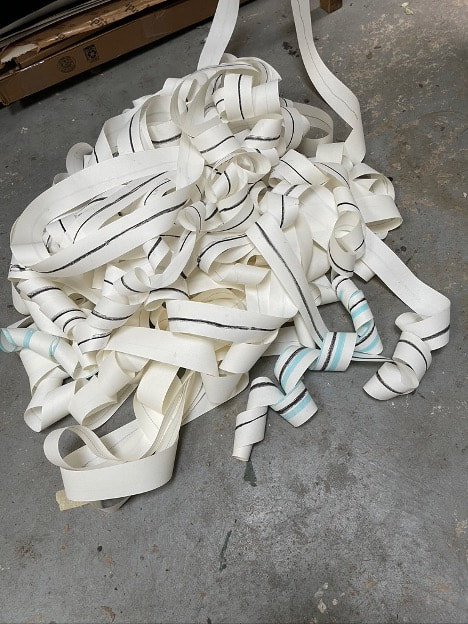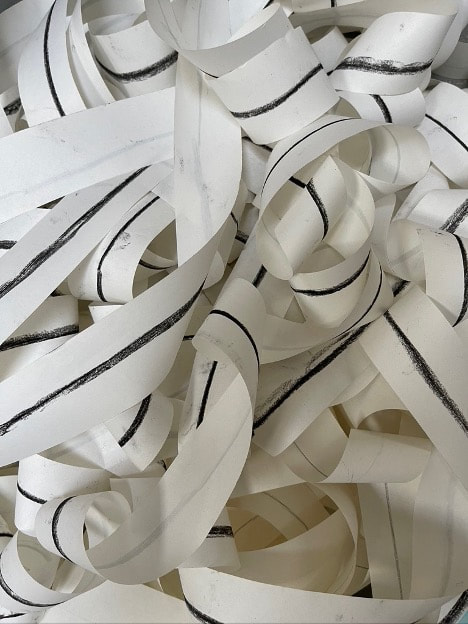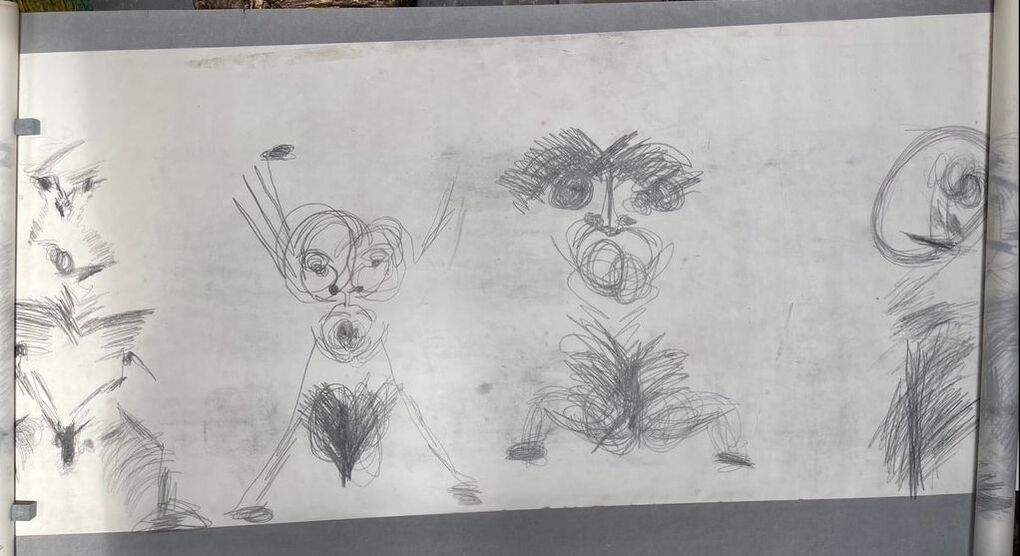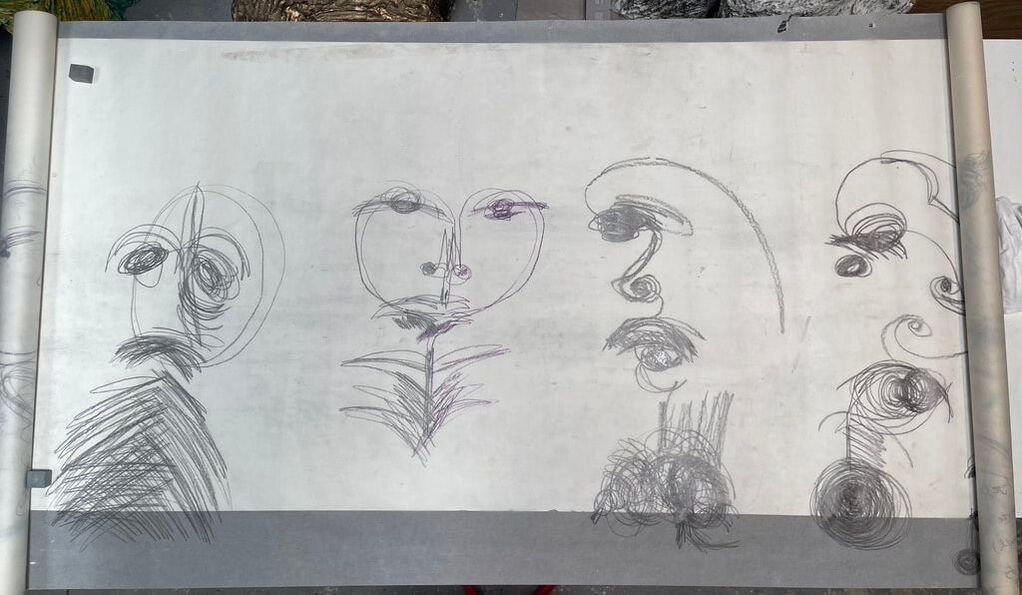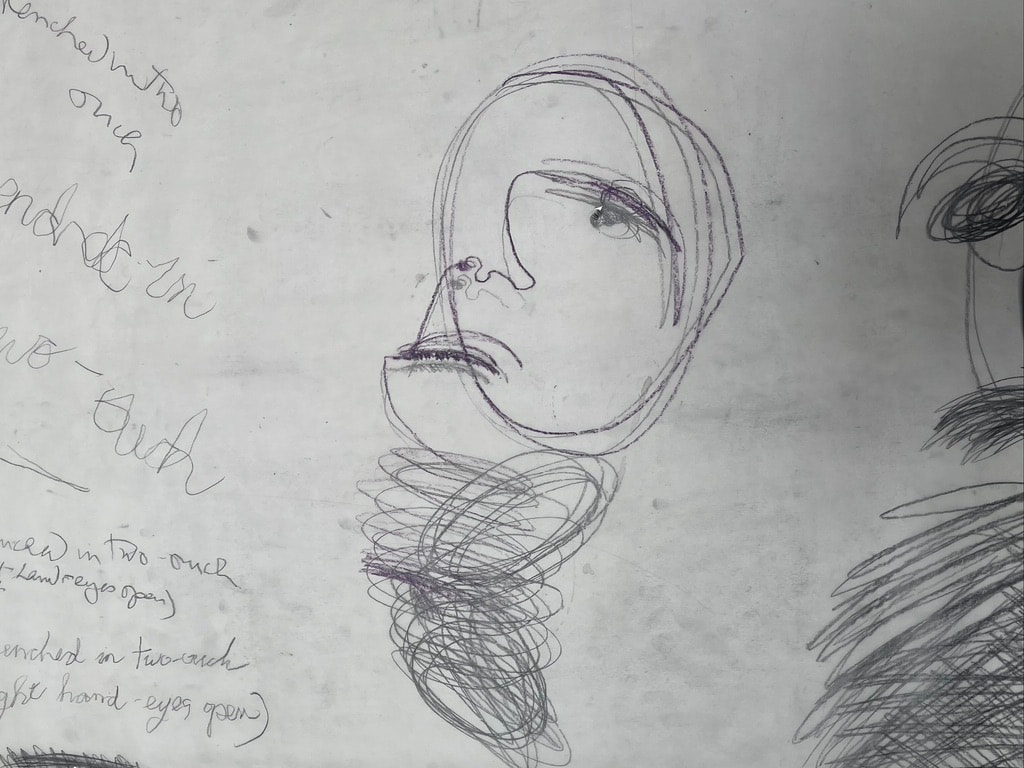Notes on Drawing/Line 2020-2023
Drawing
Drawing as why
Drawing as because
Drawing as stop
Drawing as go
Drawing as symbol
Drawing as sign
Drawing as action
Drawing as thinking
Drawing as gesture
Drawing as evidence
Drawing as trace
Drawing as mark making
Drawing as mediation
Drawing as meditation
Drawing as energy
Drawing as time
Drawing as duration
Drawing as a language
Drawing as wordless
Drawing as opaque
Drawing as transparent
Drawing as representation
Drawing as blueprint
Drawing as solid
Drawing as ephemeral
Drawing as space
Drawing as scratching
Drawing as dancing
Drawing as heavy
Drawing as darkness
Drawing as greyness
Drawing as black and white
Drawing as endless
Drawing as fast
Drawing as slow
Drawing as forever
Drawing as evidence
Drawing as concept
Drawing as tension
Drawing as performance
Drawing as mindless
Drawing as fiction
Drawing as truth
Drawing as marks versus drawing as markings. Rolande Barthes
Drawing as signs versus a mark. Walter Benjamin
Drawing as grafitti. Rosalind Krauss
Alineisalineisalineisalineisalineisalineisalineisalineisalineisalineisalineisalineisalineisalineisa……..
From the sketchbooks 2020-2023
I like the object that is the sketch book, any size, any color. I have a collection of them in black, red, blue, turquoise, green, large ones and small ones. Some are filled on every page, some are repositories for articles, images, scraps of paper, some are only partly used. They are potential, possibilities, opportunities, evidence and witness…even as the blank page stares back at me, waiting, waiting, still waiting.
What compels me to take these fragments, enlarge them and organize them as a montage, in a sequence with its own logic that becomes the scroll. I had large rolls of Arakawa Japanese paper that was waiting to be used. Perhaps, it was simply curiosity. What would these scribbles look like enlarged on a scroll, 10”x44”, the dimensions of the digital printer at the university.
These are drawings that are simple, spontaneous gestures enacted quickly, words repeated for their sound, graphic quality and rhythm. They are drawn at different moments in different sketchbooks, doodles really, throw-aways I thought. As I worked with Liz to digitize them and then to edit and select the sequencing to fit the 10”x44” format, the structure and relationship of the scribbles and words developed its own rhythm and purpose. Separately these fragments record a moment in time, together they become a script than is read as a meditation/mediation/gesture; they are more together, less when alone
Drawing
Drawing as why
Drawing as because
Drawing as stop
Drawing as go
Drawing as symbol
Drawing as sign
Drawing as action
Drawing as thinking
Drawing as gesture
Drawing as evidence
Drawing as trace
Drawing as mark making
Drawing as mediation
Drawing as meditation
Drawing as energy
Drawing as time
Drawing as duration
Drawing as a language
Drawing as wordless
Drawing as opaque
Drawing as transparent
Drawing as representation
Drawing as blueprint
Drawing as solid
Drawing as ephemeral
Drawing as space
Drawing as scratching
Drawing as dancing
Drawing as heavy
Drawing as darkness
Drawing as greyness
Drawing as black and white
Drawing as endless
Drawing as fast
Drawing as slow
Drawing as forever
Drawing as evidence
Drawing as concept
Drawing as tension
Drawing as performance
Drawing as mindless
Drawing as fiction
Drawing as truth
Drawing as marks versus drawing as markings. Rolande Barthes
Drawing as signs versus a mark. Walter Benjamin
Drawing as grafitti. Rosalind Krauss
Alineisalineisalineisalineisalineisalineisalineisalineisalineisalineisalineisalineisalineisalineisa……..
From the sketchbooks 2020-2023
I like the object that is the sketch book, any size, any color. I have a collection of them in black, red, blue, turquoise, green, large ones and small ones. Some are filled on every page, some are repositories for articles, images, scraps of paper, some are only partly used. They are potential, possibilities, opportunities, evidence and witness…even as the blank page stares back at me, waiting, waiting, still waiting.
What compels me to take these fragments, enlarge them and organize them as a montage, in a sequence with its own logic that becomes the scroll. I had large rolls of Arakawa Japanese paper that was waiting to be used. Perhaps, it was simply curiosity. What would these scribbles look like enlarged on a scroll, 10”x44”, the dimensions of the digital printer at the university.
These are drawings that are simple, spontaneous gestures enacted quickly, words repeated for their sound, graphic quality and rhythm. They are drawn at different moments in different sketchbooks, doodles really, throw-aways I thought. As I worked with Liz to digitize them and then to edit and select the sequencing to fit the 10”x44” format, the structure and relationship of the scribbles and words developed its own rhythm and purpose. Separately these fragments record a moment in time, together they become a script than is read as a meditation/mediation/gesture; they are more together, less when alone
The syntax of line.
Line is a series of works exploring the language of line as gesture, as object, as metaphor, as duration, as boundary.
Line as language:
Walking the line
A line in the sand
A red line
Line up
Holding the line
Standing in line
Keeping them in line
Stepping out of line
Coloring outside the line
Erasing the line
Drop me a line
Line backer
Follow the line
Line by line
Outline
Online
Offline
I saw an exhibition of Cy Twombly’s painting of a single continuous, textured line and I imagine him with a white oil pastel in hand walking the length of the room which was also the length of the painting, pastel touching canvas, evidence/trace of this action, this gesture. Did he use his left of right hand? Is his arm extended to arms’ length? Maybe it is at shoulder height; maybe he is facing sideways to the canvas, walking as the line is being made, maintaining a constant pace and pressure of pastel on canvas…looking forward? At the canvas or his hand making the line ? In full concentration or perhaps with his thoughts wandering to random places. What is he thinking as he walks the line? How fast or slow is he walking? How much pressure does he use on his drawing tool? Is it consistent? Are the variations of pressure and density of line recorded on the canvas as he is walking and marking?
A roll of paper
A roll of paper, 2-3 inches wide; the kind used in adding machines.
Right hand holds one end of the roll.
Left hand holds charcoal.
Right hand pulls the roll
While left hand draws a single charcoal line continuously on the roll
Right hand continues to pull, un-scrolling the roll
Left hand moves the charcoal along in rhythm with right hand pulling the roll
The roll continuously drops to the floor creating a looping pile
Lines of fallen paper, marked with a single black line, looping and disappear in a loose pile
Another configuration of line
Line is a series of works exploring the language of line as gesture, as object, as metaphor, as duration, as boundary.
Line as language:
Walking the line
A line in the sand
A red line
Line up
Holding the line
Standing in line
Keeping them in line
Stepping out of line
Coloring outside the line
Erasing the line
Drop me a line
Line backer
Follow the line
Line by line
Outline
Online
Offline
I saw an exhibition of Cy Twombly’s painting of a single continuous, textured line and I imagine him with a white oil pastel in hand walking the length of the room which was also the length of the painting, pastel touching canvas, evidence/trace of this action, this gesture. Did he use his left of right hand? Is his arm extended to arms’ length? Maybe it is at shoulder height; maybe he is facing sideways to the canvas, walking as the line is being made, maintaining a constant pace and pressure of pastel on canvas…looking forward? At the canvas or his hand making the line ? In full concentration or perhaps with his thoughts wandering to random places. What is he thinking as he walks the line? How fast or slow is he walking? How much pressure does he use on his drawing tool? Is it consistent? Are the variations of pressure and density of line recorded on the canvas as he is walking and marking?
A roll of paper
A roll of paper, 2-3 inches wide; the kind used in adding machines.
Right hand holds one end of the roll.
Left hand holds charcoal.
Right hand pulls the roll
While left hand draws a single charcoal line continuously on the roll
Right hand continues to pull, un-scrolling the roll
Left hand moves the charcoal along in rhythm with right hand pulling the roll
The roll continuously drops to the floor creating a looping pile
Lines of fallen paper, marked with a single black line, looping and disappear in a loose pile
Another configuration of line
Time
I am a time millionaire, my mother always said about her widowhood
About time
Marking time
Making time
Doing time
Wasting time
Slow time
Quick time
Just in time
Timeless
Release time
Time waits for no man
Time and time again
Saving time
No time like the present
What time is it
Is It time yet
Not enough time
Too much time
There is time enough
It’s about time
Telling time
Time for a change
Your time is up
Less time
Timeless
More time
Your time
My time his time
Her time
Their time
Our time
Time to go
Running time
Tracking time
Time zones
Digital time
Analogue time
Stop time
Once upon a time
Standard time
Time and a half
Double time
Timetable
Recorded time
Timing
Time to leave
Time for every season
River of time
Wrong time
Time management
Passing time
Best time
Time flies
Give it time
In due time
Bad time
Good time
Time honored
Time crunch
Sometimes
Time immemorial
A broken line ----- horizontal-------------------------------------------------------------can go on forever
A broken line is visually different from a continuous straight line
Line is time, duration—duration to make, duration to see, duration to endure.
Broken line disrupts time; visually causes tension and desire to restore the broken line
On a horizontal paper or support, a circle can float and be light or heavy, small or large,
or medium large or small
It is always framed by the paper which contains it, defines it, confines it…yes, defines it because a black shape is read in relation to the whole space around it and its’ relationship to the 4 edges.
I see these shapes/lines on the horizontal or vertical sheets of paper, like objects, sculptural.
The black shapes are about depth, dark, imaginative voids, holes.. no, more like voids than holes…like Anish Kapoor’s dark voids. Smaller black shapes work better than larger ones to create a sense of voids
I am a time millionaire, my mother always said about her widowhood
About time
Marking time
Making time
Doing time
Wasting time
Slow time
Quick time
Just in time
Timeless
Release time
Time waits for no man
Time and time again
Saving time
No time like the present
What time is it
Is It time yet
Not enough time
Too much time
There is time enough
It’s about time
Telling time
Time for a change
Your time is up
Less time
Timeless
More time
Your time
My time his time
Her time
Their time
Our time
Time to go
Running time
Tracking time
Time zones
Digital time
Analogue time
Stop time
Once upon a time
Standard time
Time and a half
Double time
Timetable
Recorded time
Timing
Time to leave
Time for every season
River of time
Wrong time
Time management
Passing time
Best time
Time flies
Give it time
In due time
Bad time
Good time
Time honored
Time crunch
Sometimes
Time immemorial
A broken line ----- horizontal-------------------------------------------------------------can go on forever
A broken line is visually different from a continuous straight line
Line is time, duration—duration to make, duration to see, duration to endure.
Broken line disrupts time; visually causes tension and desire to restore the broken line
On a horizontal paper or support, a circle can float and be light or heavy, small or large,
or medium large or small
It is always framed by the paper which contains it, defines it, confines it…yes, defines it because a black shape is read in relation to the whole space around it and its’ relationship to the 4 edges.
I see these shapes/lines on the horizontal or vertical sheets of paper, like objects, sculptural.
The black shapes are about depth, dark, imaginative voids, holes.. no, more like voids than holes…like Anish Kapoor’s dark voids. Smaller black shapes work better than larger ones to create a sense of voids
blind drawing, with left and right hand, 1988
The original (non reversed scroll) was part of an installation titled, Contradictions/Possibilities,1988, Niagara Artist Centre, St. Catherines , Ontario. The ‘blind drawing scroll’ was one of many elements.
The ‘blind drawing scroll’ was done more or less in one sitting. My rule was to draw using graphite, with eyes closed and using left hand and right hand. I am left handed.
I did not have preconceived images in mind. My interest was with so-called ‘automatic writing/drawing’ and I wondered if this method drawing with eyes closed, would provide a more immediate access to my subconscious and result in a more spontaneous, improvisational experience. The objective of the exercise was to eliminate the gap between my subconscious and conscious action/gesture. I do remember having ideas and maybe fleeting images, like thinking about the female body or feeling anger. It was a meditative and and enlightening experience which I was never able to repeat. Although, I was surprised by the results. I think there is always some level of self-consciousness or self-awareness in this process I just described.
The reciprocity between the movement of the arm and body in the gesture of drawing and the thoughts and images produced would be an interesting study.
The original (non reversed scroll) was part of an installation titled, Contradictions/Possibilities,1988, Niagara Artist Centre, St. Catherines , Ontario. The ‘blind drawing scroll’ was one of many elements.
The ‘blind drawing scroll’ was done more or less in one sitting. My rule was to draw using graphite, with eyes closed and using left hand and right hand. I am left handed.
I did not have preconceived images in mind. My interest was with so-called ‘automatic writing/drawing’ and I wondered if this method drawing with eyes closed, would provide a more immediate access to my subconscious and result in a more spontaneous, improvisational experience. The objective of the exercise was to eliminate the gap between my subconscious and conscious action/gesture. I do remember having ideas and maybe fleeting images, like thinking about the female body or feeling anger. It was a meditative and and enlightening experience which I was never able to repeat. Although, I was surprised by the results. I think there is always some level of self-consciousness or self-awareness in this process I just described.
The reciprocity between the movement of the arm and body in the gesture of drawing and the thoughts and images produced would be an interesting study.
